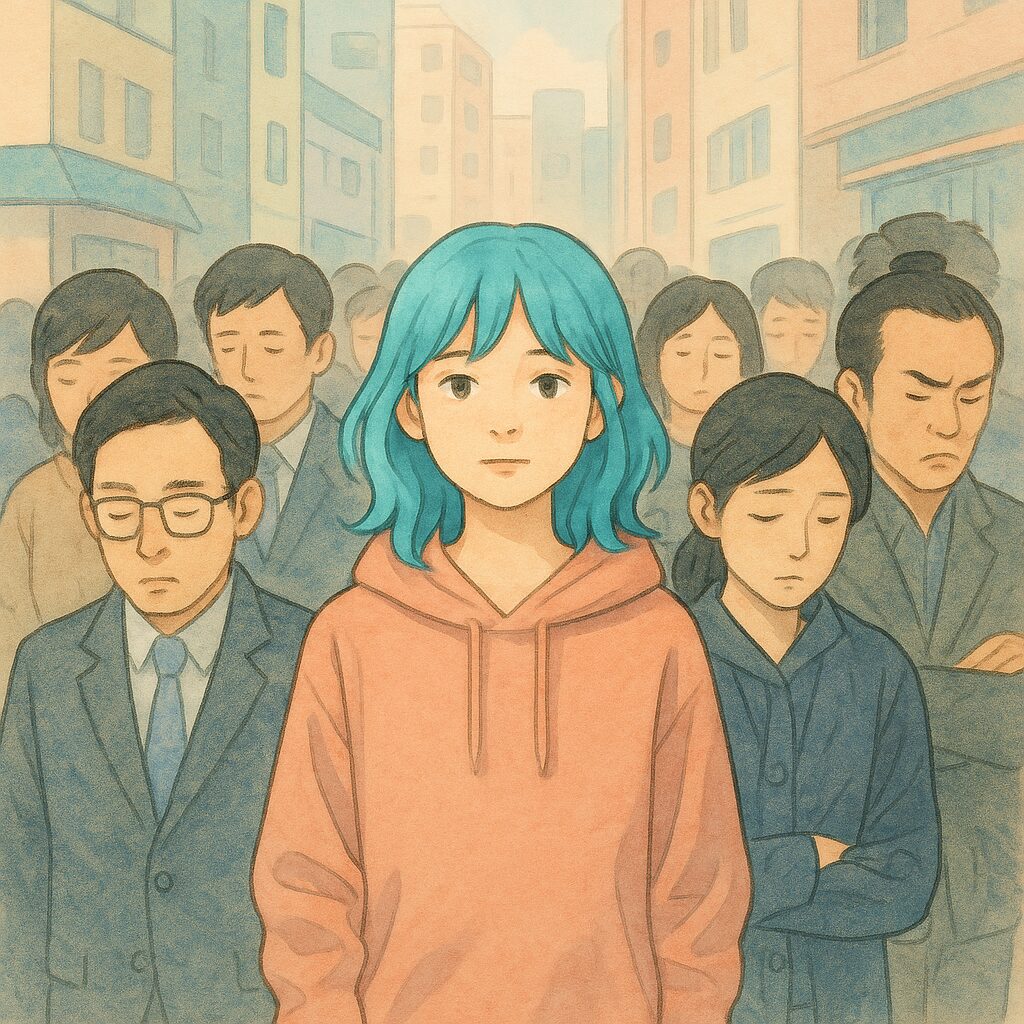- Introduction: The Invisible Pressure Foreign Visitors Feel
- Chapter 1: “Wa” and Harmony—Misunderstood Roots of Cooperation
- Chapter 2: How Modern Japan Reinforces This Norm
- Chapter 3: The Bright and Dark Sides of Social Awareness
- Chapter 4: Signs of Change—A New Generation’s Rebellion
- Conclusion: Redefining Harmony in Modern Japan
Introduction: The Invisible Pressure Foreign Visitors Feel
Many foreigners visiting Japan are struck by an atmosphere of calm politeness—quiet trains, tidy fashion, and courteous behavior. But beneath this surface lies a deeply ingrained cultural trait: a heightened sensitivity to how one is perceived by others. This invisible pressure, often called “reading the air,” has shaped Japan’s social harmony for centuries, but also presents unique challenges in the modern age.
This article explores the origins, impacts, and ongoing transformation of this collective mindset, with clear examples from history, education, and everyday life.
Chapter 1: “Wa” and Harmony—Misunderstood Roots of Cooperation
In 604 CE, Prince Shotoku established the Seventeen Article Constitution, which begins with the famous line:
“Harmony is to be valued.”
This phrase is frequently taught in schools as “don’t fight—get along.” But this oversimplification overlooks its true meaning. A fuller interpretation reads:
“Harmony is to be valued. Leaders should be gentle, and subordinates honest. Debate thoroughly before decisions are made. Once decided, all should follow.”
Far from enforcing silence or submission, Shotoku’s ideal was dialogue-driven cooperation. Unfortunately, modern education rarely teaches this deeper meaning, leading to a culture where “going with the flow” replaces constructive debate.
📜 Historical Example: The Edo-Era Five-Household System
During Japan’s Edo period, the “Goningumi” system grouped five households together under shared responsibility. If one member broke the law, all five were punished. This system encouraged neighbors to monitor each other—a precursor to today’s silent social surveillance.
Chapter 2: How Modern Japan Reinforces This Norm
📱 Case Study: Social Media and Public Shaming
In 2020, a young man walking through Shibuya without a mask was photographed and shared online. Within hours, his name, workplace, and private details were exposed—a public punishment for deviating from social expectations.
Such incidents demonstrate how Japan’s tradition of silent peer pressure has merged with digital technology to form a new kind of “watchful village.”
🏫 School Example: Brown Hair Must Be Dyed Black
In a well-known case from Fukuoka, students with naturally brown hair were instructed to dye it black. This reflected the belief that personal traits should not stand out—and that conformity was more important than authenticity.
From uniforms to classroom behavior, Japanese education often teaches children that blending in is not just preferred—it’s expected.
Chapter 3: The Bright and Dark Sides of Social Awareness
🌟 Positives: Clean Streets, Orderly Behavior
Tokyo’s famously clean streets have almost no public trash bins, yet litter is rare. Why? Because Japanese people internalize the idea that their actions affect others, even without anyone watching.
Punctuality, courteous service, and public etiquette are all supported by this social conscience. Tourists often praise Japan’s politeness and reliability as key strengths.
🌑 Negatives: Burnout and Self-Effacement
However, excessive awareness of others’ opinions can lead to mental strain. One employee shared how he was constantly performing for his boss—never able to express himself—until he developed burnout.
Social withdrawal, overwork, and depression are often tied to the invisible pressure of “fitting in.” When people prioritize others’ judgments over their own identity, stress builds silently.
Chapter 4: Signs of Change—A New Generation’s Rebellion
✨ Youth Culture: Breaking the Mold
In districts like Harajuku, young people embrace colorful hair, gender-neutral fashion, and expressive media posts. For many, social media is a canvas for personal identity, not just group approval.
Petitions against outdated school rules and demands for diversity are growing. Today’s youth are sending a message: individuality and harmony can coexist.
🌍 International Voices: Encouraging Dialogue
A French exchange student once remarked:
“Japanese people are so polite—but they often stop talking when disagreement arises. I wish they spoke up more.”
This speaks to a global desire for Japan to rethink harmony—not as quiet submission, but as a balance between self-expression and mutual respect.
Conclusion: Redefining Harmony in Modern Japan
Japan’s deep respect for harmony has created a society that’s clean, punctual, and thoughtful. Yet this same value can turn restrictive if misunderstood. The original vision of Prince Shotoku emphasized debate, empathy, and agreement—not silence.
As Japanese culture evolves, a new ideal may emerge—one where cooperation embraces individuality, and harmony is built not on fear, but on trust.



コメント